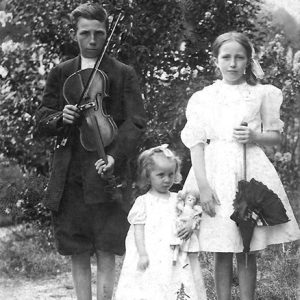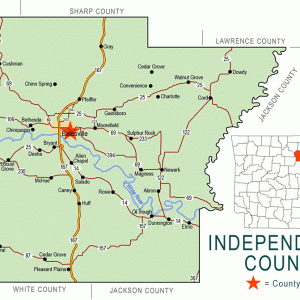calsfoundation@cals.org
Caney (Independence County)
Caney Creek begins as a spring in the hills of the Ed Taylor Holler at McHue (Independence County), moves east through Southside (Independence County), and empties into Salado Creek near the Old Rock Bridge between Salado (Independence County) and Rosie (Independence County). Caney, a pioneer community, emerged along its banks in the early 1800s on what is today Kyler Road, where it intersects with Highway 167 South (Batesville Boulevard).
Pioneer farmers found the alluvial land along the banks of Caney Creek to be ideal for the growing of grain crops, including corn (which could be used in the profitable moonshine business). One of the first to make his home in Caney was John Kyler from Tennessee, who appeared on the census in Arkansas Territory in 1830; Kyler Cemetery in Caney is named for him. His second wife was Margaret Brundrett, widow of Henry Holdway. Her father was John Brundrett, born in Cheshire, England, who was living on Caney Creek by 1834, according to county tax records. John Kyler was the Independence County judge from 1844 to 1846. By the 1850 census, he was listed as having one female slave, Mary, who was born in North Carolina. Mary is listed as Mary Kyler on the 1870 census and was still living in the Kyler household, most likely as a domestic servant.
John and Margaret Kyler had two sons. Their son John S. Kyler married Elizabeth Spangler, and Joseph Thomas Kyler married Mary Elizabeth Linebarger. The Spangler family from Alabama and the Linebarger (a.k.a. Lyenberger) family from Lincoln County, North Carolina, were also pioneers of Caney. Jacob Hill Linebarger married Sarah M. Cryseller in North Carolina and began a large family. By 1838, he and his family were living along Caney Creek in Round Pond. One of their sons, Peter Linebarger, became a blacksmith and built a shop next to his house in Caney. Linebarger married Mary Ann Brundrett, a sister to Margaret Kyler. Their brother, James Brundrett, was postmaster at Rocky Point (Independence County) on the eve of the Civil War. A sister, Harriett Brundrett, married Peter Linebarger’s brother Absalom Linebarger. Still another brother, Franklin Brundrett, married Peter and Absalom’s sister, Sarah Frances Linebarger. Close family ties existed among the early settlers of Caney.
John Kyler and Peter Linebarger were appointed members of the Independence County Home Guard (for Confederate service) by the Independence County Court in special session held on June 29, 1861. The Arkansas Secession Convention had officially called on all the counties in the state to appoint “a home guard of minute men” for local defense until a regular army could be deployed. The men appointed as home guard members were prominent in their communities, and most were considered wealthy by the standards of the day. As a result of the strong feelings in support of secession, Caney and Rocky Point became hotbeds for Rebel activities in Independence County during the Civil War. The military road running from what today is called the Rosie Valley to Pleasant Plains (Independence County) and on to Little Rock (Pulaski County) was only about four miles away, providing easy access to the Union army using the road on their travels to and from Batesville (Independence County).
Peter Linebarger and his brother-in-law, James Brundrett (also a member of the Independence County Home Guard), died in 1863 during the war under circumstances unknown. Peter’s nephews, Jacob and John Pegg, served in Company B, Eighth Arkansas Infantry (CS), enlisting at Oil Trough (Independence County). John Pegg became a corporal and was captured in November 1864 in Franklin, Tennessee. He was sent to a prisoner-of-war camp at Douglas, Illinois, but was exchanged for a Federal soldier in March 1865 in Maryland, shortly before the end of the war.
Peter Linebarger is buried in Kyler Cemetery. According to a local story, jayhawkers one night desecrated Linebarger’s grave and then rode to the Linebarger family house, where his widow and daughter lived. There, they robbed the pair of Peter Linebarger’s fiddle and some money, as well as the family’s horses, as they made their getaway. The next day, Mary Linebarger, daughter Lavinia, and Minerva Brundrett (widow of James Brundrett) dressed as men and tracked down the jayhawkers, reclaiming at gunpoint their horses and a few other stolen items, including the fiddle.
Situated between Hutchinson (Independence County), whose post office opened in the year 1900, and McHue, whose post office opened in 1896, Caney slowly lost its separate identity following the Civil War, which took a heavy toll on the families living there. Businessmen from the north, often dubbed “carpetbaggers,” began filtering into the area, with bases of operation in nearby Pleasant Plains and what is now Southside.
A small school called Caney Creek School was built about 1900 but merged with nearby Baker School at McHue around 1920; Baker later became part of the new Southside School in the 1948–49 school year. Caney never had a post office, and the post office at Rocky Point closed in 1878, with that adjoining community fading away. Caney residents relied upon country stores in nearby communities. The Linebarger blacksmith shop, which survived until the automobile age arrived in Caney in the early 1900s, was the only business in the community.
There is no church in Caney, but there are several in nearby Southside and other area communities. The only business of note in Caney is Packs Discount Lumber Store, but there are many businesses in Southside. Anderson’s Promise Land—a nonprofit therapeutic horse ranch offering free horse-riding therapy for those with disabilities—is located on Kyler Road.
For additional information:
McGinnis, A. C. “A History of Independence County, Ark.” Special issue. Independence County Chronicle 17 (April 1976).
Kenneth Rorie
Van Buren, Arkansas
 Allen Family Children
Allen Family Children  Baker School Students
Baker School Students  Independence County Map
Independence County Map 




Comments
No comments on this entry yet.